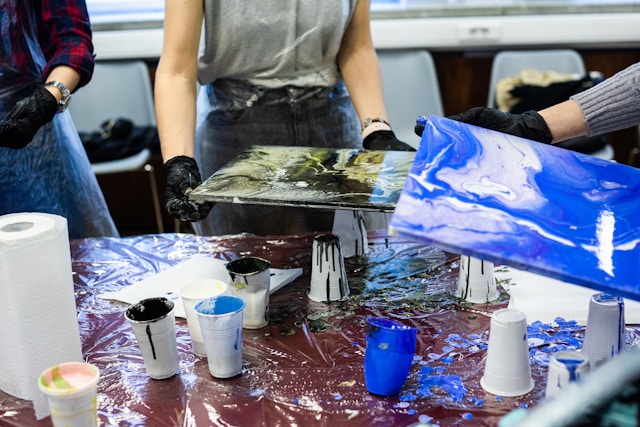Emotional pain is not always spoken in writing. Sometimes they hide behind the silence, tears, or tension in their chest. At these moments, art therapy offers a different kind of language. It is built on colors, shapes and symbols.
Art therapy helps people express and process pain in ways that they often cannot speak. It provides a safe space to explore buried emotions through difficult emotions, traumatic memories, and creative expressions. For many people, using colour and symbolism is a path to healing.
In this article, we explore how individuals can release pain, understand emotions, and reconnect with themselves by using colours and symbols in art therapy.
What is art therapy?
Art Therapy is a mental health practice that combines creative processes with therapeutic support. This is led by trained experts who use art-based techniques to help individuals overcome emotional and psychological challenges.
You don’t have to be an artist. The goal is not to create beautiful things, but to make meaning. Through drawing, painting, collage, or sculpture, people visually explore their thoughts and feelings.
According to the American Art Therapy Association, art therapy improves emotional resilience, self-awareness and coping skills, especially for individuals who recover from trauma or deal with anxiety, depression and addiction1.
Why visual expression is important
Not all emotions can be explained easily. Some trauma survivors may not have a word about pain. Others may be overwhelmed or afraid to speak.
That’s where visual expression becomes powerful. Using colors and symbols, people can express what they feel without having to talk. This kind of creative release provides a bridge between the inner and outer worlds.
A 2017 study published in Frontiers in Psychology found that trauma survivors who participated in ART therapy showed improved emotional regulation and reduced PTSD symptoms, particularly when encouraged to use symbolic image 2.
The language of colour in art therapy
Color can instantly convey emotions. Without the need for explanation, single colours can reflect mood, memory, or emotional states.
Common emotional connections with color:
Red: Anger, Strength, Passion, Fear Blue: Sadness, Calmness, Isolation, Peace Yellow: Joy, Hope, Energy, Anxiety Black: Sadness, Protection, Empty: Healing, Renewal, Je Purple: Transformation, Mystery, Dignity
In art therapy, clients often choose colours intuitively. A person may create a picture with dark blue and black swirls to express his sadness. Later, they may add yellow or green as they begin to feel hope or growth.
The therapist gently explores what each colour means to an individual. The goal is not to assign fixed meanings, but to invite personal reflection and emotional release.
Use symbols to tell the story
Just as colours express the mood, symbols help to tell a deeper story. They allow people to express painful experiences through images, giving shape to feelings that feel abstract or overwhelming.
Common symbols for art therapy are:
Trees: Growth, Grounding, Family History House: Safety, Childhood, Road to Home Life, Or Road: Journey of Life, Direction, Heart of Uncertainty: Door/Window of Love, Loss, Vulnerability: Escape, Opportunity, Barrier: Emotion, Purification, Depth
Symbols often appear naturally. Those who deal with childhood trauma may draw a cracked house. Those who grieved the loss may sketch an empty chair. These images become a minor phor – a visual cues of the emotions they carry.
In one session, the client may draw a river blocked by stones. Over time, the stones change and show healing and emotional flow movements.
Symbolic distance safety
One of the main reasons why colour and symbols are effective in art therapy is that they provide emotional distance. Rather than relating traumatic events, clients can express themselves in a phorical way.
This symbolic distance makes it easier to process painful memories without being overwhelmed.
Art Therapy Study in 2016: The Journal of the American Art Therapy Association found that individuals using symbolic images in art therapy sessions reported lower levels of emotional distress and improved ability to reflect difficult experiences3.
This is especially useful for those who have experienced trauma or complicated sadness.
Reality Example: Healing Through Colors and Symbols
Lena, 28, began art therapy after surviving emotional abuse. She struggled with words. Her therapist encouraged her to start with colour.
“I painted a lot of black at first. I didn’t even think about it. Then one day I added a red line to the page, which felt like anger – the anger couldn’t feel myself before. A few months later, I started adding greens and yellows.
Lena’s story shows how colours and symbols can cause pain and transformation in a powerful and quiet way.
What does the session look like?
In a typical art therapy session focusing on emotional pain, the therapist is:
We encourage clients to choose a colour that represents how they feel. We propose to draw symbols and scenes from recent memories and dreams. Explore artwork together through open-ended questions. “What does this shape or color mean to you?” “Where do you feel this emotion in your body?” “What would you add to this image to show healing?”
Clients can speak as much as they please. The artwork becomes the voice.
Start colours and symbols at home
While it is ideal to work with a certified art therapist, you can begin exploring this process at home as part of your self-care or healing routine.
Try this:
Mood Painting: Uses only colors (no images or shapes). I’ll draw your feelings. Symbol Collage: Cuts out symbols from magazines that reflect current emotions. Visual Journaling: Draw everyday objects that represent how your mind feels. Color Timeline: Create a color-coded journey of your life – each stage marked with different shades.
These activities can provide insight and relief, especially in times of stress and reflection.
Final Thoughts: Art as a language of healing
Not all pain requires words. Sometimes you need colour. Sometimes it needs a symbol that only you understand.
Using colours and symbols in art therapy offers a way to handle emotional pain with safety, creativity and compassion. It allows you to explore what is inside without judgment. It gives shape to things that were previously invisible, and in doing so it opens the door to healing.
You don’t have to be an artist. You need to have a willingness to express yourself. Using all brush strokes or pencil marks brings you a step closer to understanding, liberation and peace.
sauce
American Art Therapy Association. (2023). What is art therapy? (https://arttherapy.org) ↩Haeyen, S., et al. (2017). Art therapy and symbolic expression in trauma treatment. The frontier of psychology. ↩Kaimaru, G. , Ray, K. , & Muniz, J. (2016). The use of symbols and emotional regulation in art therapy. Art Therapy Journal. ↩





